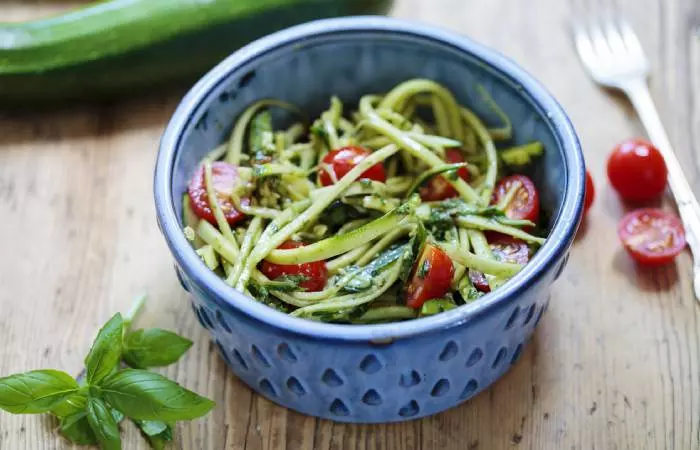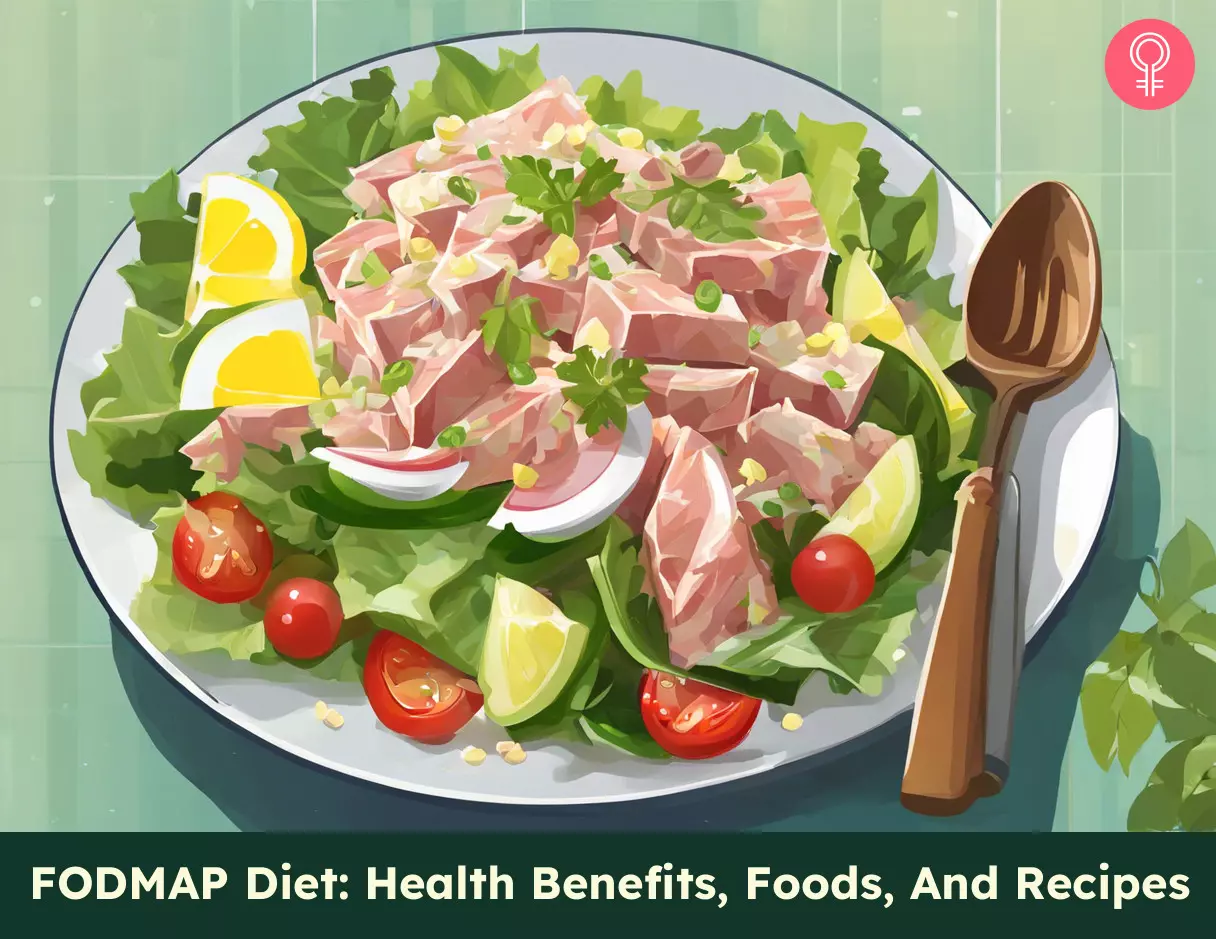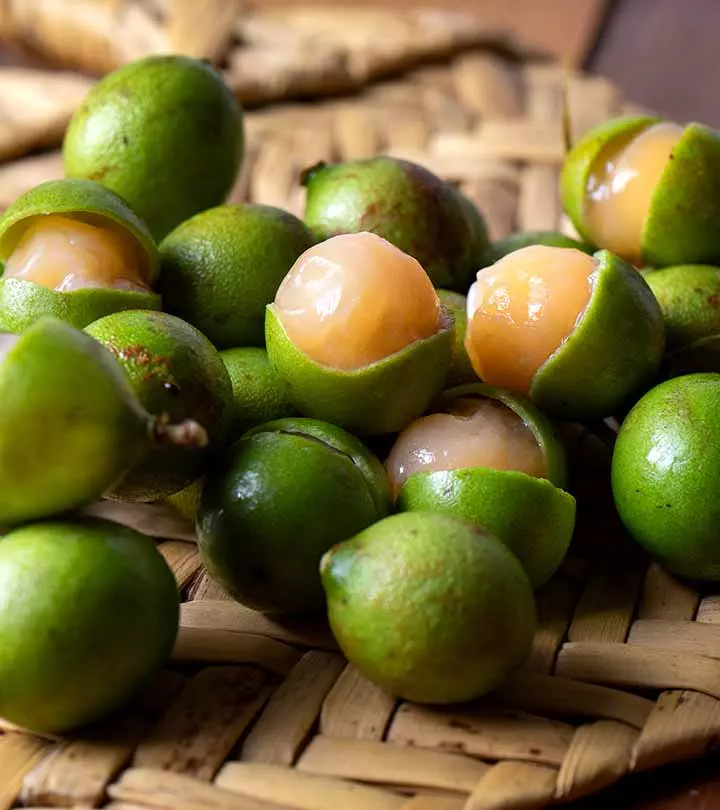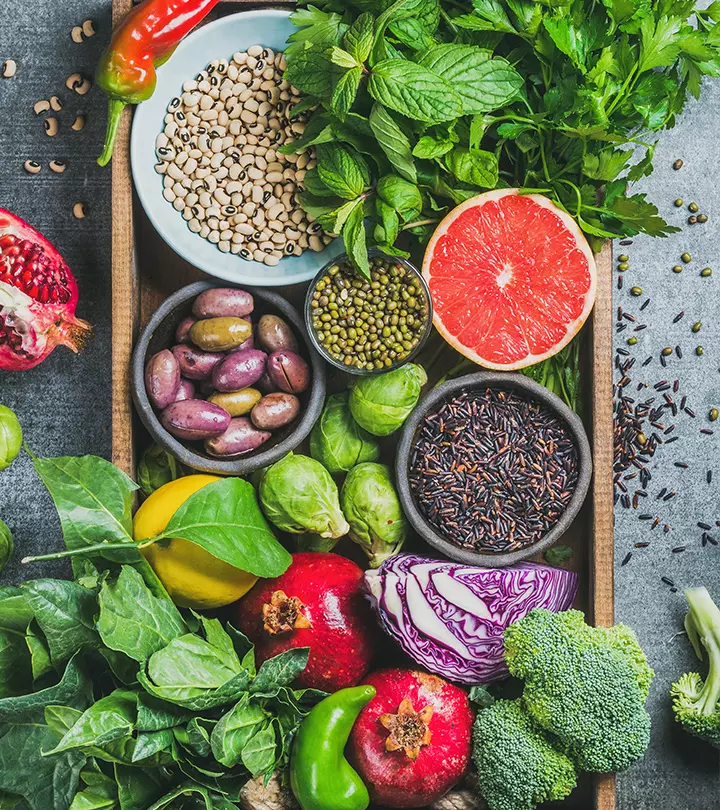FODMAP Diet: Health Benefits, Foods, And Recipes
Unlock the door to digestive harmony with a balanced diet and mindful eating.

Image: Shutterstock
The FODMAP diet is an approach designed to address gastrointestinal disorders like irritable bowel syndromei A common gastrointestinal disorder that affects the large intestine and causes abdominal pain, bloating, diarrhea, and constipation. (IBS) by creating a gut-friendly environment and reducing digestive discomfort. It mainly focuses on eliminating certain foods and reintroducing them one at a time to identify the potential trigger foods. This approach helps you control and manage the symptoms better, which may help improve your quality of life. However, it is important to work with a healthcare provider to create a balanced diet plan that caters to your dietary needs. Keep reading to understand how the FODMAP diet works and learn more about its benefits, foods to include and avoid, and more. Scroll down!

 At A Glance: FODMAP Diet
At A Glance: FODMAP Diet- Principle: Focuses on reducing the consumption of specific carbohydrates that can trigger digestive issues and IBS symptoms.
- Purpose: To alleviate gastrointestinal or digestive discomfort.
- Who It Is For: People with irritable bowel syndrome or other gastrointestinal disorders such as small intestine bacterial overgrowth (SIBO), chronic constipation, etc.
Who Should Avoid: Pregnant and breastfeeding women, people with eating disorders, and anyone without digestive issues. - Cons: May lead to nutritional deficiencies and have social implications.
In This Article
What Is A FODMAP Diet?
The FODMAP diet is designed to help manage the symptoms of digestive issues like irritable bowel syndrome (IBS) and other gastrointestinal disorders and allow the gut to heal. FODMAP stands for “fermentable oligosaccharides, disaccharides, monosaccharides, and polyols.” These short-chain carbohydrates do not get digested easily and are poorly absorbed in the small intestine, causing digestive issues in some people.
The FODMAP diet involves a three-phase approach (1):
- Restriction Or Elimination Phase: During this phase, people eliminate high FODMAP foods from their diet for 2–6 weeks.
- Reintroduction Phase: This phase focuses on reintroducing the FODMAP food groups into your diet. The foods are gradually introduced, one at a time, to identify which foods trigger digestive discomfort. This phase lasts around 6–8 weeks and should be done under the supervision of a healthcare professional.
- Maintenance Phase: This involves restarting a regular diet and focusing on restricting only the FODMAP foods that aggravate IBS symptoms.
 Did You Know?
Did You Know?So, a low FODMAP diet promotes the healing of the gut, helping reduce abdominal discomfort and multiple associated issues. Scroll down to learn more about the benefits of this dietary approach.
Key Takeaways
- The FODMAP diet is designed to alleviate symptoms of irritable bowel syndrome and other digestive issues.
- Eliminating specific foods from the diet and reintroducing them one at a time may help to identify specific triggers that cause digestive issues.
- The FODMAP diet is not a one-size-fits-all dietary solution. Hence, check with your doctor to create a personalized, well-balanced plan to eliminate the risk of deficiencies.
Health Benefits Of A Low-FODMAP Diet

1. May Help Manage IBS Symptoms
A study conducted by the Department of Gastroenterology, Monash University, Australia, found that a diet low in FODMAPs effectively reduced symptoms like bloating, gas, and abdominal pain associated with irritable bowel syndrome (IBS) (2). This diet may also help improve the symptoms of other gastrointestinal problems and quality of life in people with IBS (3), (4), (5). Therefore, this dieting strategy is often recommended as part of IBS diets to help manage the condition.
2. May Reduce Constipation
Constipation is one of the common symptoms of IBS. Some foods high in FODMAPs also contain fiber, which is beneficial for preventing constipation. However, replacing high-FODMAP foods with suitable alternatives (low-FODMAP, high-fiber foods) may help improve this condition. But remember, consulting your healthcare provider is important to ensure the right balance of fiber intake to prevent constipation (6), (7).
3. May Aid In Weight Management
Restricting high-calorie, processed foods as a part of a low-FODMAP diet may help with weight management (6). However, limited research is available in this regard. If you want to lose some pounds with a low-FODMAP diet, consult your doctor to understand your dietary needs before making any changes to your diet.
In addition, a well-planned FODMAP diet may also help improve symptoms associated with Crohn’s diseasei A chronic inflammatory bowel disease that primarily affects the lining of the gastrointestinal tract and causes ulcers and scar tissue. and celiac diseasei A chronic autoimmune disorder caused by an adverse reaction to gluten (a protein found in wheat, barley, and rye). (8), (9).
The following sections highlight the foods to be eliminated and consumed while following the FODMAP diet. Scroll down and take a look.
High-FODMAP Foods To Avoid
According to studies, up to 86% of people with IBS may experience gas, bloating, abdominal pain, and diarrhea when they consume high-FODMAP foods. Here is a list of some common high FODMAP foods (10):
- Fruits: Peaches, pears, apples, avocados, prunes, watermelon, persimmon, nectarines, mango, cherries, plums, apricots, blackberries, and boysenberries.
- Vegetables: Sweet potato, asparagus, snow peas, cauliflower, beetroot, mushrooms, savoy cabbage, leeks, artichokes, onion, snap peas, okra, bitter melon, broccoli, shallots, and butternut squash.
- High-lactose Dairy Products: Sour cream, cottage cheese, certain commercial yogurts (high lactose, non-fermented), ice cream, and ricotta cheese.
- Legumes: Soybeans, red kidney beans, baked beans (haricot and navy beans), pinto beans, lentils, chickpeas, fava beans, and black-eyed beans.
- Grains: Wheat-based products (cereal, pasta, bread, biscuits, and waffles), barley, rye, and amaranth.
- Sweeteners: Honey, sorbitol, mannitol, lactose, fructose, high fructose corn syrup, and molasses.
- Beverages: Soy milk, oat milk, soft drinks (with high fructose), fortified wines, coconut water, rum, fennel or chamomile tea.
Low-FODMAP Foods To Eat
Here is the list of common foods that you can have on a low-FODMAP diet (10):
- Fruits: Bananas, grapes, kiwi fruit, olives, oranges, cantaloupe, lemons and limes, mandarins, passion fruits, strawberries, all melons (except watermelon), and papaya.
- Vegetables: Capsicum, green beans, carrots, cucumbers, tomatoes, bell peppers, bok choy, yams, potatoes, zucchini, eggplant, lettuce, celery, parsnip, collard greens, and parsley.
- Nuts And Seeds: Pecan, walnuts, almonds, hazelnuts, peanuts, Brazil nuts, chia seeds, pumpkin seeds, sesame seeds, sunflower seeds, caraway, and pine nuts.
- Grains: Quinoa, rice (white and brown), wheat-free grains, gluten-free bread or cereal products.
- Low lactose Dairy Products And Alternatives: Lactose-free milk, fermented probiotic yogurt, almond or rice-based milk, hard cheeses (parmesan, cheddar, and Swiss), and feta cheese.
- Protein Sources: Tofu and tempeh, skinless chicken and turkey, lean cuts of pork and beef.
- Sweeteners: Maple syrup, stevia, and sugar.
- Beverages: Water, green tea, coffee (in moderation), and herbal teas (peppermint).
- Condiments And Seasonings: Salt, pepper, mayonnaise, vinegar, mustard, and lemon juice.
Once you have an idea about what foods to eat and avoid, it’s best to plan your meals. It is recommended to consult a registered dietitian to ensure your nutrient requirements are met. Below is a sample 3-day diet plan and food suggestions as per your specific condition to help you understand how you may plan your meals. Take a look.
FODMAP Diet Plan
1. 3-Day FODMAP Diet Plan
| Breakfast | Lunch | Snack | Dinner | |
|---|---|---|---|---|
| Day 1 | 2 scrambled eggs with 1 cup of cooked spinach | 4 to 6 oz of grilled pork loin with 2 cups of mixed greens | A handful of Macadamia nuts | 4-6 oz of grilled shrimp with a side of 1 cup of zucchini noodles |
| Day 2 | ½ cup of lactose-free yogurt and ¼ cup of raspberries | 2 cups of tuna salad and ½ cup of cherry tomatoes | ½ cup of carrot sticks with 2 tablespoons of hummus | 4-6 oz of baked chicken thighs with a side of ½ cup of roasted butternut squash |
| Day 3 | 2 slices of gluten-free toast and 1 kiwi fruit (halved or diced) | 2 cups of grilled chicken salad, ½ cup of cucumber | 2 rice cakes with 1–2 tablespoons of almond butter | 4-6 oz of baked salmon with ½ cup of steamed carrots |
2. FODMAP Diet For IBS
The small intestine does not absorb FODMAPs as they are nondigestable carbs (6). So, eat less of the following food groups to improve IBS symptoms:
- Legumes and crucifers (red cabbage, broccoli, etc.), as they contain oligosaccharides (galacto-oligosaccharides and fructans)
- Mushrooms and Dairy products, as they contain disaccharides (lactose)
- Honey, dates, and sugar beets, as they contain monosaccharides (fructose)
- Fruits like apples, pears, and peaches as they contain polyols (sorbitol and mannitol)
3. FODMAP Diet For Diverticulitis
If you are struggling with diverticulitis, your dietitian may suggest following low-fiber or clear-liquid diets to improve the symptoms (11).
Low-Fiber Diet: This diet plan helps reduce the strain on the digestive system. A low-fiber diet may include:
- Cooked spinach, carrots, beets
- Canned fruits without skin
- Olive oil
- White rice or white pasta
- Fruit and vegetable juices
- Dry, low-fiber cereals
- Pumpkin or yellow squash without seeds
Clear Liquid Diet:
This diet helps relieve symptoms associated with diverticulitis (inflammation or infection in small pouches in the digestive tract) (12). This diet may consist of:
- Clear broth
- Clear juices (without pulp)
- Gelatin
- Water
- Clear electrolyte drinks
4. FODMAP Diet For Constipation
A low-FODMAP diet helps reduce bloating, gas, and constipation symptoms (5). Here is a list of some common foods to eat and avoid:
- Choose low-FODMAP fruits like kiwi, grapes, citrus fruits, and berries.
- Limit the intake of high-FODMAP veggies like cabbage, broccoli, and cauliflower.
- Consider taking probiotics like yogurt.
- Consume soluble fiber-rich foods like oatmeal, chia seeds, and psyllium husk.
In addition, avoid lactose (almond or lactose-free milk) as a part of your FODMAP diet for constipation.
5. Vegan FODMAP Diet
Many vegan foods are low in FODMAPs. They include:
- Leafy greens like spinach, kale, and lettuce
- Nuts and seeds
- Rice and gluten-free grains
- Tofu and tempeh
- Berries, grapes, citrus fruits
- Carrots, zucchini, bell peppers
- Quinoa
Planning meals on a low-FODMAP diet might initially feel overwhelming, but it can become a smooth and enjoyable process with the right strategies. Learn about them in the next section.
Tips For Meal Planning On A Low-FODMAP Diet
Here are some practical tips that you can follow to plan your meals on a low-FODMAP diet:
- Create a weekly meal and snack schedule to avoid last-minute stress or unintentional overeating.
- Preparing larger portions of your favorite low-FODMAP meals and freezing the leftovers is like having a safety net. It’s a convenient way to prepare for hectic days when cooking is not an option, reducing stress and ensuring you always have a healthy meal.
- Keep your pantry filled with essentials like rice, quinoa, lactose-free milk, etc.
- Wash, chop, and portion vegetables like carrots, zucchini, and spinach. Store them in airtight containers for easy use during the week.
- Explore new recipes by investing in low-FODMAP cookbooks, following food blogs, or downloading recipe apps. You can also rework your favorite recipes by swapping high-FODMAP items for low-FODMAP ones.
- Maintain a food diary to track what you eat and monitor any symptoms. This can help identify potential triggers and ensure your diet stays on track.
- If you share a kitchen, label your low-FODMAP meals and ingredients to avoid accidental mix-ups.
Even though the FODMAP diet foods list may appear extremely restrictive, you can still prepare delicious foods with the available options and treat your tastebuds. Scroll down to learn some simple recipes you can try at home.
FODMAP Diet Recipes
1. Zucchini Noodles

Ingredients
- 4 medium-sized zucchinis
- ½ cup of shredded Parmesan cheese
- 2 medium-sized tomatoes, chopped
- ¼ – ½ teaspoon of crushed red pepper flakes (optional)
- 3 tablespoons of extra virgin oil
- 1 tablespoon of minced garlic
- 1 teaspoon of cornstarch
- 5-6 basil leaves
- 2 teaspoons of cold water
- Salt to taste
How To Prepare
- Use a hand-held spiralizer to cut the zucchini into spaghetti-length noodles.
- Now add olive oil, garlic, and red pepper flakes into a deep skillet over medium heat until the oil bubbles.
- Then, add the zucchini noodles and cook them for 5 to 7 minutes.
- Stir in the tomatoes, basil leaves, and Parmesan cheese and cook for one minute.
- Transfer the cooked noodles to a serving dish, leaving the liquid in the skillet.
To Prepare The Sauce:
- Simmer the leftover liquid in the skillet.
- Combine cornstarch and cold water in a small bowl, then whisk it into the simmering liquid. Cook until it thickens (about 1 minute).
- Season the sauce with salt.
- Pour the sauce over the cooked zucchini noodles.
- Garnish with Parmesan cheese on top and serve immediately.
Note:
Avoid adding red pepper flakes or other spices if they trigger your IBS symptoms.
2. Tuna Salad

Ingredients
- 5 oz. of canned tuna
- 1 stalk of celery, diced
- ¼ cup of mayonnaise
- ½ tablespoon of Dijon mustard
- 2 tablespoons of fennel
- 1–2 tablespoons of chopped parsley, chives
- Salt and pepper to taste
How To Prepare
- Drain the liquid from the tuna cans.
- Then, combine the tuna and the other ingredients in a bowl.
- Enjoy the tuna salad plain or use it as a filling for lettuce wrap or sandwich.
 Quick Tip
Quick Tip3. Grilled Shrimp

Ingredients
- 1-½ oz of raw shrimp
- ¼ teaspoon of black pepper
- ¼ teaspoon of cayenne pepper
- 2 tablespoons of olive oil
- ½ teaspoon of kosher salt
- ½ teaspoon of garlic powder
- ½ teaspoon of smoked paprika
How To Prepare
- Preheat your grill to 350°F..
- Place the shrimp in a large bowl.
- Add the olive oil, kosher salt, garlic powder, smoked paprika, black pepper, and cayenne pepper to the bowl and mix well.
- Thread the shrimp on six skewers, about 8 shrimp per skewer.
- Grill them until opaque, about 3 minutes on each side.
- Serve immediately.
What you eat can have a major impact on your body. Like any other restrictive diet, the FODMAP diet also has several side effects. Scroll down to learn in detail.
FODMAP Diet Side Effects

The FODMAP diet is restrictive and may lead to reduced intake of some important nutrients like dietary fiber and essential vitamins and minerals (6). Long-term restriction of these nutrients may lead to several adverse effects like nutrient deficiencies and disordered eating. Hence, it is important to consult your healthcare provider or dietitian before starting the FODMAP diet to learn how to customize this plan according to your dietary needs and to implement it safely to avoid its side effects.
The FODMAP diet is a promising dietary approach that helps manage digestive problems by systematically eliminating foods that may trigger your symptoms. Doctors often recommend this diet for people with gastrointestinal issues as part of their special dieting strategies, such as the IBS or SIBO diet. It relieves digestive discomfort and allows your digestive system to rest and heal. However, restricting foods high in fiber vitamins and minerals may lead to some side effects like disordered eating and nutrient deficiencies. Therefore, always consult a registered dietitian to create a well-balanced diet plan that will help manage the symptoms and minimize the risk of side effects.
Frequently Asked Questions
Is coconut considered a low-FODMAP food?
Yes. According to Monash University, Australia, coconut is considered a low-FODMAP plant-based food (13).
Is turmeric a low-FODMAP food?
Most herbs and spices come under the low FODMAP list when they are consumed in moderation. In the same way, turmeric is low FODMAP food when consumed in moderation. Always consult a dietitian to determine the amount of spices you may consume safely suitable for your condition.
How to season food without onion and garlic?
Season food using alternative herbs and spices like basil, thyme, oregano, or ginger for flavor enhancement.
How long is the elimination and reintroduction phase of the FODMAP diet?
The elimination phase typically lasts 2-6 weeks, while the reintroduction phase can vary but usually takes several weeks to a few months.
How do you eat out while on the FODMAP diet?
When eating out, focus on plain protein sources and non-cruciferous vegetables, and request modifications to omit high-FODMAP ingredients from your meal.
Are gluten-free breads appropriate for the FODMAP diet?
Gluten-free breads can be suitable for those with gluten intolerance or celiac disease, but they may still contain high-FODMAP ingredients, so it is important to check labels carefully.
What breads are low FODMAP?
Low-FODMAP bread options include spelt sourdough bread, wheat-free multigrain bread, and certain types of white or whole wheat bread with specific ingredients like spelt, oats, or millet.
Illustration: FODMAP Diet: Health Benefits, Foods, And Recipes

Image: Stable Diffusion/StyleCraze Design Team
The FODMAP diet is unlike all traditional diets. Watch this video to understand how it may help manage digestive discomfort and improve your overall well-being.
References
Articles on StyleCraze are backed by verified information from peer-reviewed and academic research papers, reputed organizations, research institutions, and medical associations to ensure accuracy and relevance. Read our editorial policy to learn more.
- Irritable Bowel Syndrome and Dietary Interventions
https://www.ncbi.nlm.nih.gov/pmc/articles/PMC6423692/ - A diet low in FODMAPs reduces symptoms of irritable bowel syndrome
https://pubmed.ncbi.nlm.nih.gov/24076059/ - Low-FODMAP Diet Is Associated With Improved Quality of Life in IBS Patients-A Prospective Observational Study
https://pubmed.ncbi.nlm.nih.gov/30644587/ - Management of functional gastrointestinal disorders
https://www.ncbi.nlm.nih.gov/pmc/articles/PMC7850201/ - Efficacy of a low-FODMAP diet in adult irritable bowel syndrome: a systematic review and meta-analysis
https://www.ncbi.nlm.nih.gov/pmc/articles/PMC8354978/ - Low FODMAP Diet: Evidence, Doubts, and Hopes
https://www.ncbi.nlm.nih.gov/pmc/articles/PMC7019579/ - A Low-FODMAP Diet Improves the Global Symptoms and Bowel Habits of Adult IBS Patients: A Systematic Review and Meta-Analysis
https://www.frontiersin.org/journals/nutrition/articles/10.3389/fnut.2025.683191/full - Diet Advice for Crohn’s Disease: FODMAP and Beyond
https://www.ncbi.nlm.nih.gov/pmc/articles/PMC7762196/ - Low-FODMAP Diet
https://www.ncbi.nlm.nih.gov/books/NBK562224/ - Efficacy of the low FODMAP diet for treating irritable bowel syndrome: the evidence to date
https://www.ncbi.nlm.nih.gov/pmc/articles/PMC4918736/ - Logical hypothesis: Low FODMAP diet to prevent diverticulitis
https://www.ncbi.nlm.nih.gov/pmc/articles/PMC5095569/ - Management of diverticulitis
https://www.ncbi.nlm.nih.gov/pmc/articles/PMC1360397/ - Fermentable short chain carbohydrate (FODMAP) content of common plant-based foods and processed foods suitable for vegetarian- and vegan-based eating patterns
https://pubmed.ncbi.nlm.nih.gov/29473657/
Read full bio of Sylvia North
Read full bio of Sindhu Koganti
Read full bio of Ravi Teja Tadimalla
Read full bio of Payal Karnik



























Community Experiences
Join the conversation and become a part of our empowering community! Share your stories, experiences, and insights to connect with other beauty, lifestyle, and health enthusiasts.